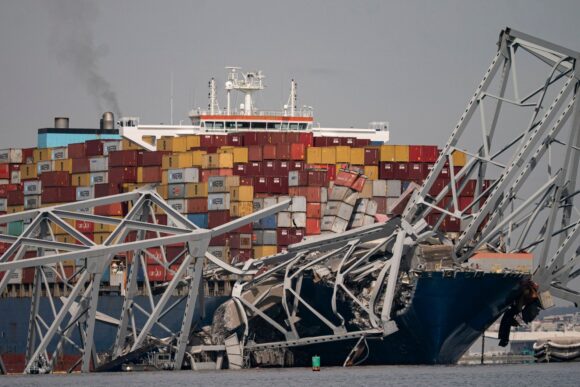How to handle complex ports and terminals business interruption insurance claims, marine and cargo damages, and marine stock claims are topics that have again come to the forefront of claims professionals’ minds following the tragic Francis Scott Key Bridge collapse in Baltimore.
Many have sought to put a figure on the total value of claims, in some cases more than $4 billion; meanwhile, the owners of Dali have sought to limit liability to the value of the vessel, estimated to be $43.67 million, according to the court filing. It remains to be seen how many policies have been triggered by this event, and the value will only be known in time.

Potential Claims
Ultimately, the numerous claims will take months, if not years, to resolve. Below are some of the potential claims:
-
- Human Factors: First and foremost, with all claims where people are affected, our thoughts are with those impacted by the loss of loved ones and the injured parties. With incidents of this type it is not uncommon to see personal injury or wrongful death lawsuits or claims under life, medical, or personal injury insurance policies. Quantification of losses can include loss of earnings/income, medical, and care costs with calculations potentially requiring present value computations, actuarial table analysis and consideration of past and future earnings.
- Bridge Structure: Construction of a replacement bridge is currently estimated to cost anywhere from $400 million to $800 million or higher, with a projected duration of between 18 months and seven years depending on the type of construction chosen and bureaucratic hurdles.
- Toll Revenues: The Francis Scott Key Bridge was a toll bridge. Daily, more than 30,000 vehicles made the crossing, meaning potentially hundreds of thousands of dollars lost each day, adding up to millions over the course of the closure period and reconstruction period. The Interstate-695 bridge makes up around 8% of the Maryland Transportation Authority toll revenue.
- Cargo Damage: The average value of goods in a container is estimated to be in the range of $50,000 per TEU. Obviously, the value can vary greatly depending on whether it was carrying a Salvador Dali or Cezanne painting or plastic toys. With several of the 4,700 containers overboard and at least 13 of those still on-deck damaged, we understand that general average has been declared and is under investigation by adjusters.
- Marine Delay in Start-Up: Should the damage delay arrival of any project cargo.
- Port Blockage: Officials initially estimated closure of the port would cost the economy as much as $15 million per day. Key imports/exports at Baltimore include:
- Rougly 50 million tonnes/$80.8 billion of foreign cargo.
- More than 1 million tonnes of roll on/roll off farm and construction machinery.
- 1 million Twenty-foot Equivalent Unit containers.
- 11 million tonnes of general cargo.
- 847,158 cars and light trucks (more than any other U.S. port).
While concessions on the east side of the bridge are not blocked, those to the west are expected to be impacted for some time yet. Officials have indicated a plan to open a 35-foot-deep temporary channel within weeks with a number of vessels already having used two small temporary channels.
There is hope the entire shipping channel can be cleared by the end of May 2024, with roghly 1,000 tonnes of debris already removed. In the meantime, many vessels will be diverted to other ports along the east coast such as those in New York and New Jersey with onward travel by road and rail.
- Contingent Losses: Sometimes insurance policy extensions can be triggered by damage events in the vicinity of a business premises, or acts of civil or public authority, denial of access, or loss of attraction. Some examples could include:
- Port Tariffs: Loss of movement tariffs and charges and/or stevedoring revenue.
- Silo or Warehouse Storage: Loss of revenue while vessels are diverted to other ports.
- Increased Costs/Extra Expense: Additional cost of transportation or workarounds to mitigate a loss of revenue.
- Losses at Other Businesses Ancillary to the Port Itself: Ingress or egress policy extensions often stipulate affected property should be situated within a specified distance of where ingress or egress is prevented, which could be the start or end point of the bridge .
The extent to which losses can be mitigated will ultimately depend on the circumstances of the affected parties and undoubtedly there will be ongoing discussions, negotiations, and disputes along the way regarding the quantum of loss.
Retaining a forensic accountant early and involving other relevant experts (marine engineers, structural engineers, equipment engineers, etc.) can provide tremendous value to the claims review process. Given their unique skill sets and experience managing large or small ports and terminals claims globally, they can prove to be invaluable resources for insurance companies, independent adjusters, and law firms.
Thorpe is an executive vice president in J.S. Held’s Forensic Accounting – Insurance Services Practice, based in Dubai, UAE. He has more than 17 years of experience. He can be reached at dthorpe@jsheld.com or +971 56 658 3620.
Was this article valuable?
Here are more articles you may enjoy.


 Inspections of Affected Barrels Will Take Time as Flood Cleanup Progresses at Kentucky Distillery
Inspections of Affected Barrels Will Take Time as Flood Cleanup Progresses at Kentucky Distillery  Forecast Calls for Wildfires to Burn More Land Across U.S. This Year
Forecast Calls for Wildfires to Burn More Land Across U.S. This Year  Audi Q6, Three Other Vehicles Earn IIHS 2025 Safety Awards
Audi Q6, Three Other Vehicles Earn IIHS 2025 Safety Awards  Survey Shows Distracted Drivers Overconfident: 20% Text While Driving, 15% Use Social Media
Survey Shows Distracted Drivers Overconfident: 20% Text While Driving, 15% Use Social Media 